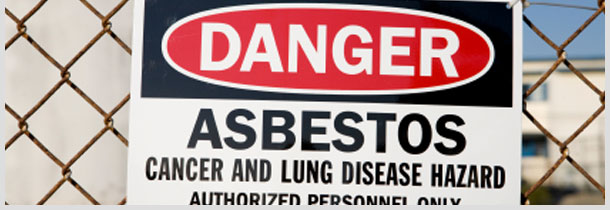By admin on March 3, 2014
 On January 10, 2014, the Hon. George R. Hodges, United States Bankruptcy Court for the Western District of North Carolina, handed down a decision that promises to be a “game changer” for asbestos manufacturers facing potentially crushing mesothelioma death claims. Top Bloomberg BNA Toxics Law reporter, Perry Cooper, discussed the decision and its potential ramifications in her recent article titled, “Sides Fiercely Divided Over Impact of Garlock Asbestos Bankruptcy Court Order” (2/26/14).
On January 10, 2014, the Hon. George R. Hodges, United States Bankruptcy Court for the Western District of North Carolina, handed down a decision that promises to be a “game changer” for asbestos manufacturers facing potentially crushing mesothelioma death claims. Top Bloomberg BNA Toxics Law reporter, Perry Cooper, discussed the decision and its potential ramifications in her recent article titled, “Sides Fiercely Divided Over Impact of Garlock Asbestos Bankruptcy Court Order” (2/26/14).
The issue before the Bankruptcy Court was how to determine a reasonable and reliable estimate of Garlock Sealing Technologies, LLC’s (“Garlock”) liability for present and future mesothelioma claims. The court rejected the asbestos claimants’ $1.3 billion liability estimate in favor of Garlock’s $125 million estimate, an order of magnitude less. Why did it do so?
The court initially determined that Garlock’s products resulted in a relatively low exposure to asbestos to only a limited population and that its legal responsibility for causing mesothelioma was relatively de minimis. During the early phase of the asbestos litigation in the 1980’s – when Garlock was generally named in complaints naming 20-50 more defendants – Garlock was very successful in settling its cases.
However, things changed for the worse by the early 2000’s, by which time large thermal insulation defendants had filed for bankruptcy and were no longer participants in the tort system. As the focus of plaintiffs’ attention turned to Garlock, as one of the remaining solvent defendants, evidence of plaintiffs’ exposure to other asbestos products often disappeared. As a result, plaintiffs’ law firms used their control over the evidence to drive up the settlements demanded of Garlock.
The crux of the court’s determination was that plaintiffs routinely denied exposure to other [bankrupt] companies’ asbestos products in pre-trial discovery and at trial, while often shortly thereafter filing multiple claims under oath with asbestos bankruptcy trusts. The “double-dipping” described by Judge Hodges where, for example, a plaintiff denies any exposure to insulation products, but after the case is settled, files 23 Trust claims, appears to be a widespread practice.
This conduct violates court rules and should be severely sanctioned if and when it comes to light. This decision shines a bright light on unethical practices in the plaintiff asbestos bar that may be a game changer particularly for manufacturers whose legal responsibility for causing mesothelioma, like Garlock, is relatively de minimis. It is the small players who are being pummeled by the lack of disclosure provided in these cases who should be seeking relief.
Garlock was able to demonstrate that in cases where it was able to obtain evidence of filed Trust  claims and use them at trial, it generally had a successful trial result. In contrast, the thermal insulation defendants’ exodus from the tort system and the subsequent “disappearance” of evidence of exposure to their products, necessitated a sea change in Garlock’s negotiating and trial strategy.
claims and use them at trial, it generally had a successful trial result. In contrast, the thermal insulation defendants’ exodus from the tort system and the subsequent “disappearance” of evidence of exposure to their products, necessitated a sea change in Garlock’s negotiating and trial strategy.
Garlock demonstrated that the availability of comprehensive asbestos exposure information was often the difference between winning and losing at trial. If plaintiffs’ suppression of exposure evidence occurred in litigation against other defendants besides Garlock, it has likely resulted in higher asbestos settlements and judgments by as much as several hundred millions of dollars. At the same time, the contingency fees harvested by plaintiff lawyers in the asbestos litigation are staggering. But we should not assume that every plaintiff law firm improperly withholds exposure evidence. Cases should be examined on a case-by-case basis.
However, asbestos manufacturers are likely to bring increasing pressure on asbestos courts to compel plaintiffs to produce comprehensive evidence of asbestos exposure. The cookie-cutter management of large asbestos dockets often sweeps the legitimate concerns of asbestos defendants, particularly the smaller players, under the rug.
Trial courts should be encouraged to come up with creative means of ensuring judicial fairness. Depending upon the jurisdiction, this may involve having the trial court retain jurisdiction to reduce a verdict or settlement to account for post-verdict claims brought against other entities, who were not identified in the trial court. Alternatively, plaintiffs should be required to file Trust claims forms before trial or be judicially estopped from doing so after settlement.
RICO claims have been successfully brought against plaintiff law firms for fraud in the past. Judge Hodges’ decision, and the underlying evidence upon which it is based, provides Garlock with strong ammunition to pursue RICO claims. Additionally, the law firms identified by Judge Hodges may be subject to increasing scrutiny by the asbestos courts in the jurisdictions where they practice. Like the asbestos defendants of yesteryear, these well-heeled plaintiff law firms make for deep-pocketed defendants.
 In a recent article for Mealey’s Litigation Report, Dallas partner James Lowery and associate Ted Yarbrough explain why defense of asbestos and talcum powder cases requires exploring alternative exposures. The article focuses on why alternative exposure minimizes the potential liability of each defendant, and how the alternative exposure case needs to be developed at all stages of litigation – from plaintiff’s deposition (the real first day of trial) up through trial.
In a recent article for Mealey’s Litigation Report, Dallas partner James Lowery and associate Ted Yarbrough explain why defense of asbestos and talcum powder cases requires exploring alternative exposures. The article focuses on why alternative exposure minimizes the potential liability of each defendant, and how the alternative exposure case needs to be developed at all stages of litigation – from plaintiff’s deposition (the real first day of trial) up through trial.
 In
In  A Connecticut state court jury recently returned a defense verdict in case alleging injury from exposure to asbestos that drifted into the air from a facility, but in doing so thrust to the forefront the potential of future similar claims in Connecticut. In
A Connecticut state court jury recently returned a defense verdict in case alleging injury from exposure to asbestos that drifted into the air from a facility, but in doing so thrust to the forefront the potential of future similar claims in Connecticut. In  On January 10, 2014, the Hon. George R. Hodges, United States Bankruptcy Court for the Western District of North Carolina, handed down a
On January 10, 2014, the Hon. George R. Hodges, United States Bankruptcy Court for the Western District of North Carolina, handed down a  claims and use them at trial, it generally had a successful trial result. In contrast, the thermal insulation defendants’ exodus from the tort system and the subsequent “disappearance” of evidence of exposure to their products, necessitated a sea change in Garlock’s negotiating and trial strategy.
claims and use them at trial, it generally had a successful trial result. In contrast, the thermal insulation defendants’ exodus from the tort system and the subsequent “disappearance” of evidence of exposure to their products, necessitated a sea change in Garlock’s negotiating and trial strategy.